Disclosure: We may earn commissions if you purchase products after clicking on a link from our site.
Are you looking for the best turkey hunting tips to take more turkeys home for dinner? Are you in search of turkey hunting tips for beginners? Whether you are an experienced or beginner turkey hunter, these turkey hunting tips will take your hunting game to the next level and help make you a more successful hunter.
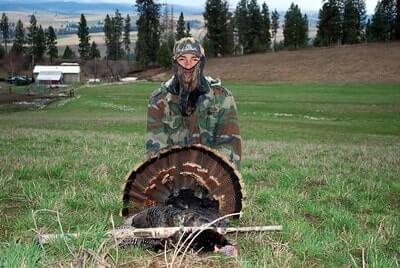
Best Turkey Hunting Tips
1. Shoot From Both Shoulders
Before the turkey hunting season begins, it is always a good idea to practice shooting your turkey gun from the opposite shoulder. With practice, when you become comfortable taking shots in this position, you will improve your chances of getting more turkeys without spooking them. This is a great turkey-hunting tip for beginners as well as experienced turkey hunters.
This is a good skill to learn because there will be situations in which the turkey comes up behind you when you are sitting at the base of a tree. Turning around to make an accurate shot is difficult if the turkey is behind your right shoulder and you are a right-handed shooter and vice-versa for a left-handed shooter.
2. Build A Blind
Evening birds are suspicious, jittery, and very alert. if you want to turkey hunt in the evening, building a hunting blind can help conceal your movement as you wait for turkeys. You can read a review of the best hunting ground blinds from this link.
3. Controlling The Volume Of Box Calls
If you are working with a gobbler with a box call and he remains at a distance from you, chances are you could be calling too strongly. The tom may think that the hen he is hearing is closer to him and will often stop and wait for her. Box calls are very loud and one way to get him coming closer to you is by reducing the volume of your call.
You can do this by holding the call upside down with the handle on the bottom and sliding your thumb up the sides to increase pressure on the call and slowly dampen the vibration. The gobbler will get the impression that the hen is moving away from him and that will make him chase her, thereby moving closer to you.
4. Play The Weather
You can use the bad weather to your advantage by hunting turkeys. If it is a windy day, look for lee hillsides, calm coulees, quiet valleys, and secluded draws where turkeys will congregate to avoid the wind.
If it’s raining, leave the woods and watch a field or meadow where birds will be preening when the rain stops. On a cold day, go to the sunny field edge where hens go to get the sunlight and warm up. There just might be toms following the hens.
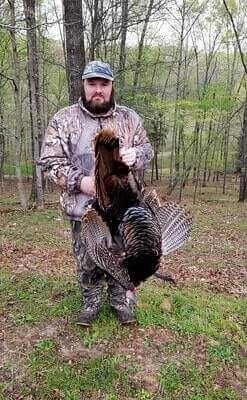
5. Recondition Your Box Call
If you notice that your box call sounds dull and lifeless, chances are the chalk that increases friction between the paddle and the sides of the call is gummed with foreign material. Remove the old chalk residue using a green scrubby and then apply a fresh coating. Do not use sandpaper to remove the old chalk residue as this will damage the box call.
6. Glass A Rim Strutter
Gobblers strut in the woods and glades of canyon slopes. They also go to the canyon rim and strut there if there is a pasture or crop field around. Using hunting binoculars and a spotting scope you can locate them. We did a review of the best hunting binoculars and you can read it from this link.
Glass rim-edge turkeys from 2 or 3 miles away, oftentimes from the opposite side of the canyon. When you have found an edge, move in and get ready for a shot.
7. Late-Season Turkey Decoys
Use turkey decoys when most hens are sitting on their nests. They are effective late in the season and not in the early season when most toms will already be attended by hens. You can learn how to pattern deer in early season for this article.
8. Take The Shot
If a gobbler is within 40 yards and pops his neck out like a periscope, that’s your shot; take it. This is one of the best turkey hunting tips to follow through on. You will be amazed at how many turkeys you take down if you just follow this and not try to rationalize it in your mind.
9. Roosted Flock In The Spring
If you are hunting a gobbler that is roosting a bunch of hens, try to bust the flock off the roost the evening before your hunt. They won’t go very far and will not be grouped as usual and this could make the gobbler more responsive to your calling in the morning.
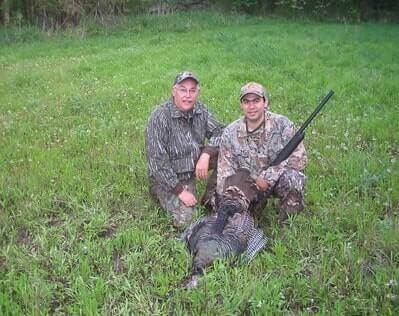
10. Be The Deal Closer
As a turkey gobbles and moves closer to you, don’t continue calling. Just sit, be prepared, and wait for him. However, if he suddenly stops and hangs up 60 or 70 yards away, just coax him secretly. If he gobbles or drums, or stirs leaves with his feet, cluck, yelp, and purr softly.
A gobbler’s hearing is not at its best when he gobbles and it makes it difficult for him to nail down your exact location. He will have to move 20 or 30 yards closer to find that sweet-talking hen. That’s when you take him down.
11. Set Up a Place For a Gobbler
With good scouting, you will know where a gobbler has roosted for the night. You might also have knowledge of where he goes after flying down. Set up to call him between where he roosted for the night and where he goes after flying down, about 100 to 200 yards away from his tree. Be there before the break of dawn and do it quietly as roosted birds are sensitive to sounds and movements even in the dark.
12. Closer Than You Think
Don’t let the acoustics of the habitat deceive you when a turkey gobbles. He might be closer, sometimes much closer than he sounds. When an Eastern turkey roars in the timber, it seems like it rattles the ground.
When a Rio Grande or Merriam turkey gobbles on an open plain, he sounds like his head is stuck in a coffee can. The sounds turkeys make can fool you that they are farther than they really are. Be prepared.
13. Gobbler Too Close For A Shot
When a gobbler trots into your setup, don’t wait too long to take a shot. You have the best chance of putting a pellet into it from 20 to 30 yards. If he gets too close to you, your pellets might be packed so tightly together that you could miss him.
14. Fringe Benefits
Your mocking calls to a lead hen may not bring in a gobbler, but it just might reveal a satellite tom traveling with a small breeding flock. He might not gobble and may not be the dominant bird, but take him nonetheless.
15. Finding Roosting Gobblers
When you locate a roosting area by scouting or calling, they will fly up into the trees. Just remember that they pick their spots to sleep when they are in the trees, not when they are on the ground.
16. Mocking The Lead Hen
When you are working with a gobbler that struts with a few hens, always listen carefully to the dominant and most vocal hen. Mirror and mock her. When she yelps, you yelp If she clucks, you cluck back.
This will rile up the lead hen and she may just come looking for the new hen in the territory. Her movement and desire to see that new sassy hen might bring the gobbler along into your shooting range.
17. Lonely Gobblers
During the middle of the day, around eleven o’clock in the morning, hens leave the gobblers to attend to their nests. This is the time the toms get lonely and start to gobble, thereby giving up their location. Many turkey hunters miss this opportunity to get a turkey because they are not alert to the situation of the gobbler during midday.
18. Learn To Play The Terrain
When you are searching for a gobbler and suddenly hear one gobbling in the distance, don’t set up right there and start calling. Instead, move closer to the gobbler, and with your movement and the shuffling of leaves, the gobbler will think that another turkey is coming his way. He will gobble at that sound of the movement. Set up then and be ready for the gobbler when he shows up.
19. Rake Leaves To Call Gobblers
If you have a situation in which the gobbler remains at a distance responding to your calls but not coming closer to you, stop calling and start imitating the sound of a feeding hen by raking the leaves with your hands. Most likely, the gobbler will get frustrated that the hen that is scratching for food isn’t responding to his calls and will come closer to find out why.
20. Throw A Curve Ball
If it is possible, set up to call within gun range of a bend in a logging road. Gobbling turkeys like to step out into a curve where he constructs and looks both ways down the road for hens.
21. Be Ready To Shoot When A Tom Stops Gobbling
When a gobbling turkey becomes silent, don’t think he is no longer interested. Don’t resume calling. Instead, get ready to shoot. Usually, when the turkey stops gobbling, it could be that he is on the way.
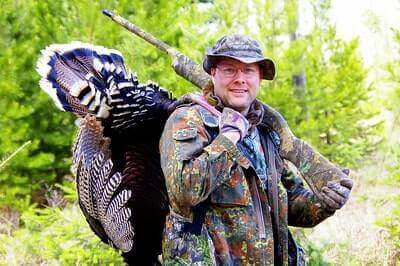
22. Mix It Up
If you have worked the same gobbler from one location for a number of days, alter your approach the next morning. Work him from a different location and set him up in a fresh spot. Use a different call from the one you used the previous days. Be more creative to get the turkey.
23. Setup Fake Flock of Fall Turkeys
Although turkey hunters usually use decoys to get the attention of gobblers, turkey decoys can also be used for fall turkeys. Use many of the decoys to simulate a small flock. If you locate where the turkeys roost and where they feed, set up your fake flock between these two places and use a couple of different calls to mimic the sound of feeding hens.
24. Reading Turkey Marks
Gobblers make 2 1/2 inches-long toe prints. If you find narrow, squiggly grooves to either side of a track, they are “strut marks” where a blown-up bird scraped off the tips of his wing feathers. Hen droppings are small and spiraled while a gobbler scat is bigger, curved like a fishhook, and splashed with white.
25. Box Calls In The West
When a strong wind is blowing or when turkeys are far away across an open stretch of prairie, turkey hunters in the Rio Grande and Merriam will often encounter situations in which loud calling is needed. Using a box call is the right approach and bringing more than one box call to keep them responding.
26. Using A Binocular
Many turkey hunters don’t use hunting binoculars in hunting turkeys. They are useful in the East and in open country where Merriam’s and Rio Grande toms are located.
27. Circle Gobbling Turkeys Blocked By An Obstacle
Sometimes turkeys get stopped from coming to your calls by obstacles like streams, fences, and ravines. In such situations, you will have to go past the obstacles to find the turkey.
Keep him gobbling by using a crow call, then circle around him until you are 180 degrees away from where you were set up. The gobbler will quickly go back on a track he used to get where he is, then try to go through unfamiliar territory with obstacles.
28. Friction Calls
The best two kinds of wood for friction calls are cherry and walnut. Cherry is good for high-pitched yelps and walnut for hoarser notes.
29. Spooking Roosting Gobblers
It is very easy to get up too close to the area where you “roosted” a gobbler the night before in the pre-dawn darkness. Hence, sneak into a calling area at a safe distance from the trees where they are roosted.
30. Call Funneling
When you make a box or glass call, hold it away from your body and point it toward a ridge or creek bottom where you think a turkey may be. This will augment the volume of your yelps and cuts, and help funnel them to the areas where you think a turkey might be.
31. A Ruse For The Gobbler
When you have tried calling in a gobbler and it has not worked, try walking away from him, calling as you go. If the gobbler thinks the hen is getting away from him, he might come running to meet the hen.
32. Make Short Calls
You can locate silent gobblers by cutting on a pot-and-peg call. However, don’t make many loud, aggressive, and irregular clucks and pocks that can drown out a tom’s gobble. Instead, cut in sharp, 3-second bursts, then stop and listen.
33. Hear Distant Gobblers By Pausing
Turkeys gobble to very loud noises like sirens, gunshots, foghorns, and thunder. Pause and listen after the loud noise to find out if a bird responded to the gobbling.
34. Give Him A Break
Many turkey hunters make the mistake of yelping and clucking as soon as they hear a gobbler fly down from the tree. Don’t make that mistake. Instead, keep quiet and give the turkey some time to hit the ground, settle his feathers, and decide on what he will do next. After 30 seconds or more, then let out sweet calls. If you make the mistake of calling while he is in midair on his way down, he will not hear you.
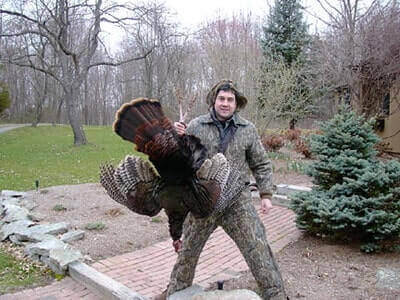
35. Clothing With Red, White, or Blue Colors
Don’t wear any clothing in any color of red, blue or white. These colors are on the heads of wild turkeys and you don’t want to be mistaken for a gobbler by another hunter. Always keep your hands and head camouflaged when calling and wear dark-colored socks and pants that cover all of your body.
36. Close the Box
According to Will Primos, if you want to Yelp on a box call, you should move the handle about an inch or so off to the side of the sounding lip and “close the box” to run two notes together. He states that light pressure on the lid will give you a raspy yelp. If you apply a little more pressure on the handle, it will result in higher notes.
37. Midday Gobblers
Turkeys do more gobbling in the morning than during midday. Many toms will gobble in the early morning even if they are with hens. You will locate them and call them but might not have success in them coming out to you.
If you are experiencing this situation, go look for a more receptive turkey. If you locate a gobbler during midday, there are good chances that he is alone and will likely come to your calls.
38. Tree Talking A Turkey
When you have crept close to a roosted turkey, set up and listen carefully. If he booms and there is no response from a hen, don’t make the mistake of calling too early. Wait until the skyline turns pink, then let out a single soft tree yelp to make him aware of your presence.
If he responds with a gobble, don’t respond. This makes him think you are a hen and he knows your location. Listen for his descent and get ready to take him down.
39. Jealous Gobbler
Simulate a breeding hen by inserting the decoy’s stake deep into the soil for the decoy’s belly touches the ground. This is the position hens get into when ready to mate. Also, put a Jake decoy behind her to convey the message that he is about to breed her.
If the tom you are hunting sees the hen and jake decoys in breeding position, he may become so upset that he just might approach your setup with his guard down.
40. Mouth Call Basics
When using the mouth call, don’t just blow across the reeds. Instead, huff air up from deep within your diaphragm. Then work your jaw up and down when you yelp as you do when you talk.
41. Bust A Roosted Flock
One of the fall turkey hunting tips used by hunters is to locate and scatter a flock of birds. The fall turkey hunters then sit and call the flock back in as they naturally want to regroup. If you can imitate the lost birds, they will use you as a homing beacon to regroup.
You can find a flock to bust to identify where they roost. Look out for large trees with many droppings at their bases. Go out the evening before your hunt to listen for sounds the birds make when they fly up for the night. Sneak into the woods before sunrise the next day and then rush the flock when they fly down.
42. Custom Fitting Your Call
If your diaphragm call is too wide and bulky in your mouth, use scissors and trim the tape skirt just a little bit. Additionally, you can bend the aluminum frame slightly downward to make a call fit comfortably and create a better air seal.
43. Silent Gobblers
If you notice that spring gobblers have all gone quiet, think about where their feed sites are and the routes they will take to get there. Then glass open areas until you locate the areas they are using and set up an ambush.
44. Mix It Up
Hens usually mix whines, purrs, moans, and delicate squeals. Listen and pay attention. These notes drive a gobbler wild. Tweak your calls to produce this effect and it just might get a tough gobbler coming your way.
45. Turkey Season Practice
Practice for turkey season by shooting your turkey gun with light trap loads. Try a few magnums before the season starts to be certain they shoot to the same point of impact.
46. Hunting On Small Properties
Tad Brown has a different approach when hunting on small properties. He believes the more you move, the more turkeys you bump and the more birds you bump at the beginning of the season, the less they will use the property.
So his solution is to use trail cameras and does a lot of glassing and observation to find the areas where he often finds gobblers. He then put a hunting blind there and just waits. additionally, he calls but doesn’t move, and in a few days, he will get the turkey. We did a review of the best trail cameras and you can read it from this link.
47. Henned-Up Birds
If you are not succeeding in calling in turkeys that are not interested, don’t spend too much time trying to bring them in if you have a lot of land to hunt on. If a turkey responds to your call but won’t move closer to you, he might be with hens. Remember the area but move on to find another more receptive turkey.
However, if you haven’t filled your tag, you can return to the spot where you were calling and heard him gobble and try calling again. It’s possible that his hens may be on their nests now and might be wondering what happened to the one that wouldn’t come see him earlier in the morning.

48. Yelp A Bird To Sleep
When you want to get a gobbler the next day, go an hour or two before dark fully dressed in camouflage clothing with a hunting vest full of calls. When you strike a bird, yelp to him just like you’re trying to kill him, but with time running late, you really can’t. Your game plan is that you want the bird to fly up and roost still looking for you.
You want him to wake up to the same call from the hen that he was gobbling to when he went to bed. If he goes to sleep with your yelp in his brain and that is the first thing he hears when he wakes up, you have a very good chance of killing that bird.
49. Boat Hunting Unpressured Turkeys
Often you might come upon properties managed by the U.S. Army Corps of Engineers. Usually, the land is open for public use but is surrounded by private property. It might be hard to access on foot and the best way to hunt this land is by boat.
Drive your boat along the shoreline early in the morning and stop to call at every location. If a gobbler responds, circle around the bird and call him into your setup.
50. Bring A Wing Man
An effective and easy-to-learn call to bring with you when turkey hunting is the wing of a gobbler from the prior year or a hen you killed in the fall. Using the wing to imitate a bird pitching off a roost when combined with a fly-down cackle is very effective and realistic.
To create a kick-butt Jake/gobbler fight, smack the wing against your pants leg and the ground while making fighting purrs and gobbles on a tube call.
51. Mountain Bike Turkey Hunting
You can also hunt unpressured turkeys on public land by using a mountain bike. Be on the lookout for a forest service or timber company road that is gated to keep out motorized vehicles. Ride your bike deep into that property, stopping to blow a locator call or yelp loudly every few hundred yards. As you ride, listen carefully for turkeys.
52. Follow The Leader
During the early season, you might be dealing with a group of gobblers all running together. When you have a group of gobblers coming toward you, only pay attention to the leader which will be the first bird coming your way.
The others will do whatever he does which includes coming to the call and running off. Therefore pay close attention to what the leader likes when it regards calling. Be sure he doesn’t spot any movement.

53. How Hunters Miss Gobblers
You may wonder how turkey hunters miss a big target like a wild turkey standing within 30 yards. Chances are the shooter is so fascinated by the wild turkey that he slightly raises his head from the gunstock, thereby putting him off and missing the turkey.
54. Second Chance On A Bumped Bird
Many gobblers will stay away from a setup because something just doesn’t seem right; it’s not because they are scared. All is not lost. You can still get them interested again.
Allow them to walk off, give them a few minutes, then move and work him from a completely different angle and location if the terrain allows it. You could try a new call or just the same one and see if he responds.
55. Call Hens To Bring In Gobblers
If you are hunting western birds like the Rio Grande or Merriam turkeys, you will be glassing open country for gobblers with many hens in the flock. One good tactic is to call the hens rather than the gobblers. If you can get the attention of the hen to investigate a noisy rival, the gobbler accompanying her may just tag along to the shooting range.
56. Gobbling To A Gobbler
Early-season gobblers are either flocked up or still in small groups trying to sort out dominance issues according to Tad Brown. In this scenario, Tad uses a gobble tube or shaker call. Many early spring toms will respond to a hen yelp, but when it is another gobbler, it could be the best way to call in another gobbler as he tries to sort out dominance issues.
57. Secure Your Box Call
You have to properly secure your box call to prevent it from giving out a scraping sound just as you are creeping into a turkey roost early morning. If this happens, your hunt may be well and truly over before it actually started.
58. Have A Plan
According to Philip Vanderpool, never call without a good tree or brush pile to set up close by. Sometimes you will walk for quite a distance without finding a bird, and then suddenly one might sound off nearby.
He can be you in no time and if you don’t have something to set up next to, you just might bump into the bird, especially during the early season when the woods are bare.
59. Expect The Unexpected
There may arise a situation in which the hens fly down from the roost while the gobbler remains on the limb and still calling. Don’t jump the gun and start thinking that the gobbler is yours. The hens may start walking in a direction away from your setup. He can then fly down and join the hens, ignoring your calls.
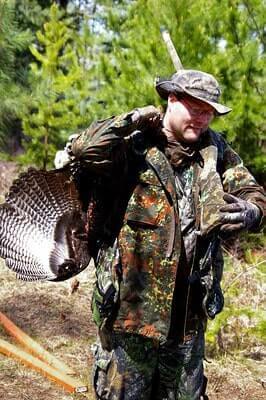
60. The Lone Gobbler
When hunting turkeys, keep on the lookout for the old gobbler that is not mixing with the younger male turkeys. He will be by himself especially early in the spring. He just hangs around and breeds hens.
He will have favorite spots and routines that have been successful for him. If you can figure out the patterns and are not super aggressive, you just might kill a big turkey.
61. Mimic A Moving Hen
If you call turkeys with a diaphragm call, throw the sound to one side or the other by cupping your hand to your mouth and then turning your head to the left or right. Turkeys can easily key into your position with their acute visual and auditory senses.
If you mimic a hen that is moving back and forth to either side of you, the gobbler you are calling in might not see in until it is within shooting range.
62. Scout Acorns To Find Turkeys
Turkeys like acorns and beechnuts. If you are hunting in a new area, you can find areas to listen for gobbles at dawn or dusk by finding areas with the prior year’s acorns. You can improve your turkey hunting skills by reading how to scout turkeys from this link.
63. Look Out For The Bone Spurs
Don’t pick up a gobbler that you have shot before he stops thrashing. They have sharp bone spurs on their lower legs that they use when fighting to assert dominance over their rivals. You don’t want to get injured after shooting the gobbler. Always place your foot on the turkey’s neck until he stops twitching and will be safe from an injury from his bone spurs.
64. Call Roosted Toms Aggressively
The conventional wisdom states that you should resort to soft tree yelps and clucks when you are calling in a roosted gobbler. However, the turkey guide, Kevin Small of Midwest Outfitting, doesn’t agree with the conventional stance. He believes you shouldn’t be passive. He wants to convince the gobbler that it should go look for you when it comes down from the tree.
Kevin starts with soft calls, but if Tom isn’t responding to his first calls, he will switch call types until the gobbler responds. He then starts cutting the tom off when he gobbles. Soon he will be gobbling every time he touches his call. If Kevin is successful in creating that scenario, most of the time he will kill that turkey.
65. Turkeys That Don’t Gobble
Some gobblers don’t always gobble. A hyped-up tom will strut, spit, and rum toward you without making any other sounds. Listen carefully for a low-frequency, rumbling hum that indicates that there is a strutting bird in the vicinity.
66. Early Season Caution
With little foliage on trees and brush in the early season, never be in a hurry to move on a gobbler. Always assume that every turkey you hear can see you because he probably can.
A turkey can see five times farther in the timber than you can so only move when you are certain that there’s something tangible between you and the gobbler.
67. Store Your Mouth Calls
Your mouth calls can last longer if you store them in the refrigerator during the off-season. This will prevent the latex reeds from warping which could ruin the sound it makes. You should also insert a flat toothpick between the reeds to keep them from sticking together.
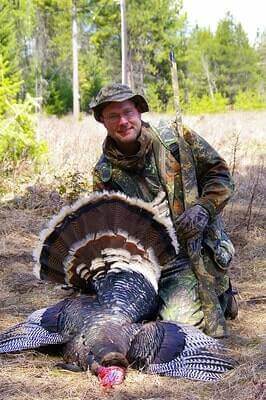
68. Calling In The Fall vs Spring
Calling like a hen to fall gobblers will not yield the results you want. You need to be a new gobbler. In the fall, gobblers, jakes, and hens all go into separate flocks.
69. Bumping Into A Moving Gobbler
Use yelps with caution when you try to locate gobblers. An enthusiastic tom may respond by moving toward your position and could possibly bump into you before you are set up.
Use a crow or owl locator call that will allow you to pinpoint his location without motivating him to search out the source of the sound. If the call doesn’t work, then you resort to yelps and move carefully when setting up on any birds that respond.
70. Stop Calling Tough Toms
You can bring in a tough tom is to not call him at all. Make him aware of a hen nearby by flapping a turkey wing and scratching in the leaves at your feet and then stop. Responding to his gobbles by yelping may keep him in his position because he thinks the hen is interested in him and she is heading his way.
Usually, the hens move toward the gobblers, not the gobblers toward the hens. Not calling at all will make him wonder what he’s doing wrong and just might come closer to attracting the hen’s attention using visual rather than auditory signals.
The Bottom Line
Whether you are an experienced or beginner turkey hunter, you always want to improve your hunting skills and knowledge to become a better turkey hunter and take home more turkeys. In this article, we have compiled some of the best turkey hunting tips to help you become a better hunter.